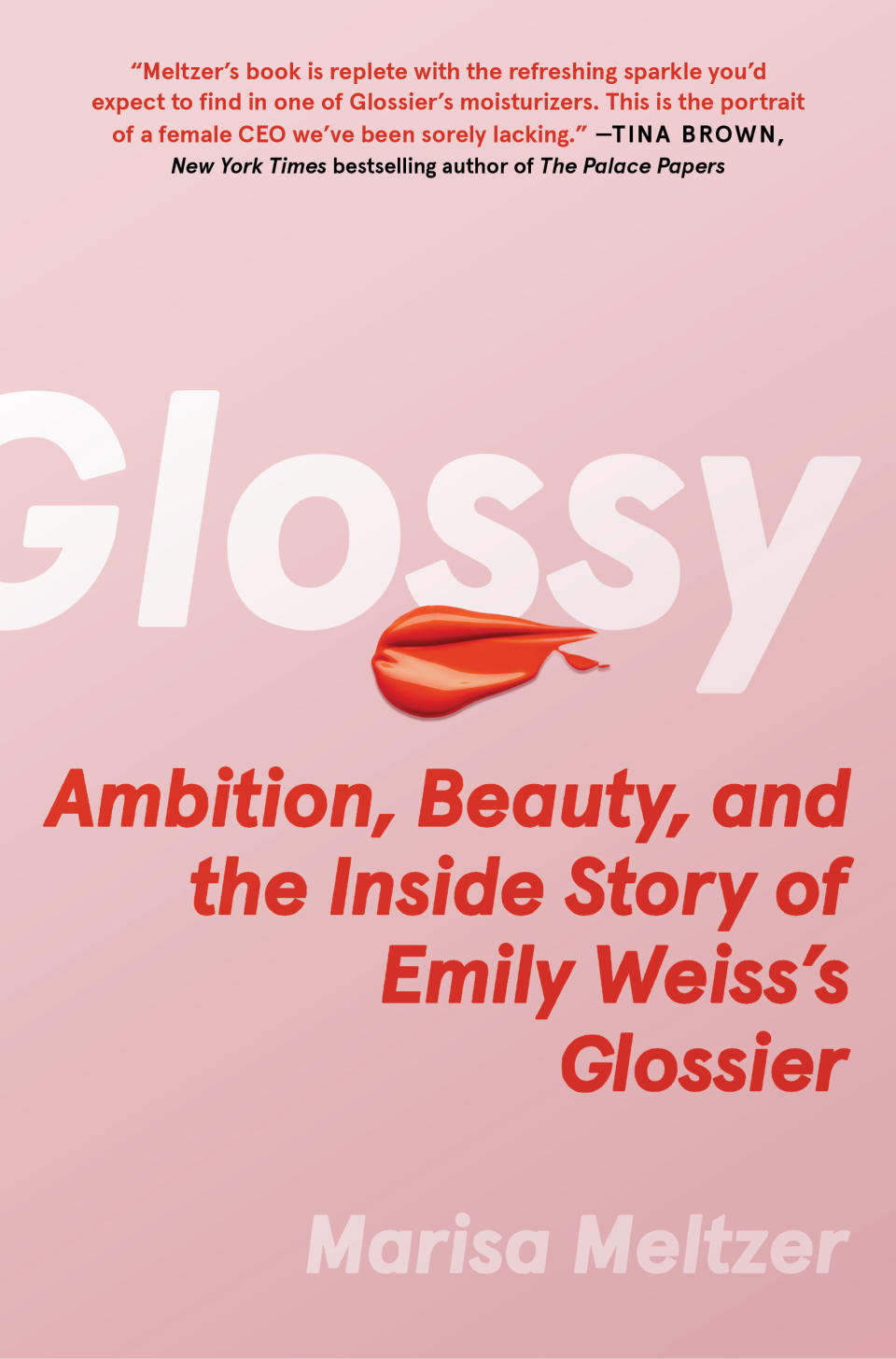Marisa Meltzer Explores Glossier’s Origin Story

When Emily Weiss stepped down as chief executive officer of Glossier in May 2022, Marisa Meltzer was finishing the first draft of her book, “Glossy: Ambition, Beauty, and the Inside Story of Emily Weiss’s Glossier” (Atria/One Signal, $28.99), about the beauty company Weiss founded in 2014 and built into a Millennial and Gen Z cult brand with a $1.8 billion valuation. Meltzer, a veteran journalist who previously profiled Weiss for Vanity Fair, admits that her “first reaction was a certain amount of anxiety about whether that made this book less important.”
Then the schadenfreude rolled in. The New York Times declared the decision by Weiss (then expecting her first child) to cede day-to-day control to Kyle Leahy — an experienced former executive at Cole Haan who joined Glossier in 2021 as chief operating officer — as the “sunsetting of the girl boss.” The term, ushered in during the exuberant (and possibly irrational) start-up boom of the era, was a cute moniker that was embraced despite being obviously misogynistic. If it once connoted success, it had morphed from a media-ready cool-girl sobriquet to a stand-in for “toxic white feminists,” as Meltzer writes. After the social justice protests of the summer of 2020, the racial undertones became inescapable; with the young female CEO as corporate culture Karen.
More from WWD
“I think any time gender and capitalism and women’s liberation are conflated, it gets weird really fast,” Meltzer tells WWD.
Meltzer offers the Spice Girls as an analogy. The pioneering girl group of the late 1990s may have been singing about girl power, but their message was completely “divorced” from the Women’s Liberation Movement of the ’60s and ’70s, when second wave feminists took to the streets to demand equal pay and bodily autonomy.
“’Girl boss’ was this funny moniker for these women in business,” Meltzer says.
The cohort also included Leandra Medine of Man Repeller; Audrey Gelman and Lauren Kassan, cofounders of the now-defunct women’s social club the Wing; Steph Korey, founder of suitcase brand Away; Tyler Haney, who was pushed out as CEO of her once-hot athleisure brand Outdoor Voices, which she now mocks on Instagram, and of course, Nasty Gal founder Sophia Amoruso, who popularized the term in a bestselling book about her scrappy rise from dumpster-diving college drop-out to venture-backed mega-stardom. Leaning into the girl boss aesthetic, adds Meltzer, was a way for female founders, “to get press and to have the press not be about what they were wearing or their personal lives.”
Now, she continues, “it’s like calling someone a hipster or saying Dimes Square, no one wants to claim it. No one wants to call themselves a girl boss. But everyone knew what you were talking about.”
If you’re trying to sell your vision to the (overwhelmingly male and white) venture denizens of Silicon Valley’s Sand Hill Road, “being in this easy to digest category of cool Women in Business certainly helps,” Meltzer says.
Of course, it was no coincidence that this group of young female founders were, as Meltzer tells WWD, “conventionally attractive, lived in big cities, were socially connected.”
And before the racial reckoning, “it was easy to focus on that cohort of women without really thinking about who was excluded from it and why,” she adds.
But if Weiss pitched Glossier as a company that empowered its customers (via online feedback about products), its actual remit was to sell brow pomade and face tint. And it wasn’t even trying to sell face tint to everyone. The brand was very early on criticized for a dearth of products for darker skin tones. (It has since significantly expanded its foundation shades.)

And it wasn’t just the lack of products for people of color. In the summer of 2020, as racial justice protests were sweeping the country, an anonymous Instagram account of former Glossier employees detailed “an ongoing insidious culture of anti-Blackness, transphobia, ableism and retaliation” at Glossier’s retail locations. Weiss issued a public apology and vowed to do better. Days earlier Glossier had announced widespread layoffs at its retail locations, which had been shuttered during the pandemic. Meltzer reached out to the account — called OuttaTheGloss — but they did not respond.
Weiss’s company was among several female-founded businesses that had taken a reputational hit for backroom policies and behavior that were at odds with the veneer of acceptance marketed to consumers. Glossier sales began to decline in 2021, more layoffs followed. Meanwhile celebrity-backed companies — Rihanna’s Fenty Beauty (which launched with 40 foundation shades), Selena Gomez’s Rare Beauty, Hailey Bieber’s Rhode — began to dominate the beauty start-up scene.
“Glossy” is a deeply reported but still breezy chronicle of a the post-#MeToo VC-fueled founder era as personified by Weiss — who many people first met via a memorable cameo as a Vogue intern in the unscripted series “The Hills.” Dubbed the “super intern,” Weiss parlayed her access to boldface names in the fashion and beauty industry (she also interned at Ralph Lauren) into a successful beauty blog called Into the Gloss. In the pre-influencer era, the readability of Into the Gloss was grounded in its authenticity. The product recommendations came with irresistible personal anecdotes (Courtney Love enthused about a Bioxidea Miracle24 facial mask that she said “made her look like she just had sex for four days,” writes Meltzer) and ran the gamut from a tube of $2 Blistex Medicated Lip Balm (Jenna Lyons) to $60 Chanel Rouge Allure Incandescente 97 (Alexa Chung).
Weiss was driven, writes Meltzer, and had a hard time relinquishing control. She was also tenacious and unafraid to ask for things. Before Into the Gloss launched, Weiss cold-called an executive at Lancôme and talked them into being the blog’s first advertiser; Lancôme spent $5,000. In an interview with NPR, Weiss claimed: “This was more money than I’d ever had in my life, and more money than I ever had in my bank account.”
In the book, Meltzer notes dryly: “That sounds unlikely for someone who routinely wore Gucci and Chloé, but [Weiss] seems invested in her origin story.”
Weiss was also just as invested in Glossier’s origin story. In interviews, she has presented it in almost divine terms; it was a calling for her and she expected it to also be one for Glossier employees, even those who were working hourly retail jobs. It worked. Its critics may have dubbed Glossier as makeup for people who don’t need makeup. Still, the waiting list for new products could be in the thousands. And the first permanent Glossier store, which opened in SoHo in 2016, became an immediate destination.
The path to launching her own direct-to-consumer beauty line was less of a one-woman-show. Weiss needed advice, guidance and funding. Kirsten Green, the founder of VC firm Forerunner Ventures, which launched Warby Parker and Birchbox, among others, was an early supporter and provided seed funding. With Green’s help, Weiss secured $8.4 million in series A funding through Thrive Capital.
But the thing that earned Weiss the funding and entree into the girl boss cohort — her attempt to position Glossier as a company at the intersection of beauty and tech — was the thing that caused the most consternation at Glossier. Meltzer writes that there were endless meetings about positioning Glossier as a “nebulous social commerce-meets-social media network for beauty fans.” But there was no real plan or strategy for how tech would underpin Glossier. There were discussions of an app that could, among other things, be a place for Glossier customers to connect, converse and meet-up, all while the company collected “data on their habits.” By 2017, one third of Glossier’s employees, around 50 people, were in the tech departments. None stayed long; a product manager who had worked at Facebook and Instagram lasted six months. And they were expensive, some were “offered interior designers for their apartments” to lure them from Silicon Valley to New York. As it became clear that the tech aspect of Glossier was essentially rudderless, employees in the tech department, writes Meltzer, didn’t want to ride the elevator with Weiss, “not because she was icy” and there was no “unofficial rule that she was to ride the elevator alone, but because they dreaded her sunny disposition. They felt doom and gloom about the app, while they viewed her as optimistic to the point of ignorance.”
And Glossier had trouble keeping pace with market demands. By 2019, the dewy, fresh face look that was the Glossier aesthetic was supplanted by more dramatic makeup with deep jewel tones (as seen on the cast of HBO’s “Euphoria”). Glossier attempted to pivot; launching Glossier Play in early 2019, but the offering was decidedly off-brand and somewhat bungled.
As Meltzer writes, “it went sideways.” The launch was chaotic. “People weren’t just staying late, but lying on the floors, stressed out from the pressure of wanting to do a good job and crying in front of their coworkers.” Customers complained that Glossier’s Glitter Gel was made with non-biodegradable glitter. The company responded by advising customers to wash the glitter off with a cotton pad and Milky Oil cleanser to “avoid getting glitter into the waterways.” Glossier Play lasted less than a year.
“There are a couple of Dropbox folders with a few $100,000 images that no one will ever see,” one anonymous employee tells Meltzer of the aborted marketing campaign for Play, while unused custom packaging was “said to be worth around $100,000.”
At the same time, “Glossy” does give Weiss her due. Glossier is among a handful of female-founded companies of its era that has so far weathered the exit of its founder. (Weiss remains as executive chairwoman.) Weiss had long resisted a retail partnership, while demurring acquisition overtures from established brands. Since February, Glossier’s entire product line has been available at Sephora’s 600 retail locations. And it’s still not unusual for the company’s stores to have a line outside. Gen Z fans still flock to the SoHo flagship for the You Look Good selfie mirrors and pale pink cocoon of acceptance. Of course, Leahy will need to continue to scale up in order to satisfy investors that funneled nearly $300 million into the company. And that means continually launching new products and marketing them effectively.
“The psychology of how we shop for beauty, or fashion for that matter, is about desire and wish filament and aspiration,” Meltzer tells WWD. “But the challenge for Glossier is less about their community and more about product development. The main challenge is finding those killer products.”
And that’s the actual job of a boss, even one with a killer origin story.
Best of WWD


